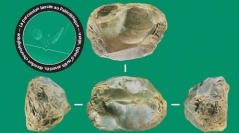

 Comptes Rendus Palevol
20 (21) - Pages 373-400
Comptes Rendus Palevol
20 (21) - Pages 373-400The work presented in this paper is the result of a more general study of all the non-flint lithic materials carried out on several sites of the early Upper Paleolithic of the Vézère valley (Dordogne, France). Among the many objects in this category, we present here only those showing traces of percussion use. Although these traces are most often present on river pebbles, other types of materials have also been used, including the re-use of flints originally knapped for something else. The study concerns three Aurignacian rock shelter sites (abri Blanchard and abri Castanet in Sergeac and Abri Cellier in Tursac) and the Final Gravettian levels of two other rock shelter sites (Pataud and Laugerie-Haute in Les Eyzies-de-Tayac). The collections studied have very different origins: collections from old excavations, collection from the spoil of old excavations and current excavations. Thus, these collections are very heterogeneous. Among the studied material, a macroscopic analysis revealed the presence of different categories of percussion tools, corresponding to diverse uses.
Percussion tool, percussion, Aurignacian, Gravettian